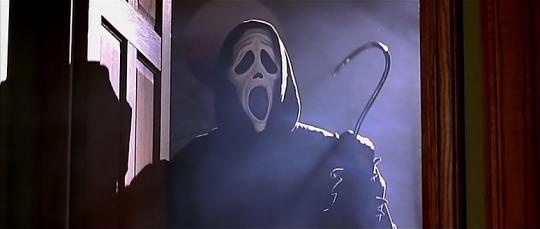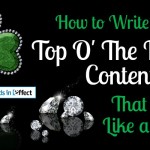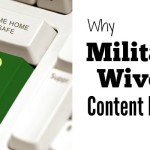
Do you remember sitting beside the campfire as a kid, being taught to fear the creepy guy with a hook for a hand?
(You know, the hook that could be heard scraping the teenagers’ car door: Screeeeeeeee.)
Maybe that’s why, as adults, many content writers give scant attention to the hook in their stories—the opening sentence (or two or three) designed to capture readers’ attention and interest and draw them in for the kill.
If this describes you, it’s time to face your fear. Take a big breath, make a creative leap, and give your readers apleasant surprise.
Why Your Hook Must Be Fierce
Neglecting your hook can be a fatal mistake.
A dull hook can’t cut through the clutter, and it won’t reach readers at their core.
When people are lured by a great headline and begin wading into the body copy below, they want to be hooked. They’re begging for it. If you don’t hook your readers right away, they’ll make themselves scarce in a hurry.
Publishing brand content without a good hook is like launching into a major speech without acknowledging your audience. In a sea of competing content, where consumers’ attention so easily drifts, your success or failure will depend largely on how you craft your opening lines.

How to Write a Hook That Will Slay ‘Em
Here’s a great exercise: Look closely at the hooks used in feature stories, in-depth news articles, blogs, and opinion essays. Assess their creativity and effectiveness. Think about what you might have done differently.
Below are some classic tricks writers use to pique their readers’ interest.
Begin with an intriguing anecdote.
Give a few key details so readers will want to know what happens next.
An example from GE’s content hub, gereports.com:
Hilary Monaco has a black belt in Taekwondo, and she can take a few punches. When her sparring partner landed a hard kick to her head during practice last fall, she didn’t think much of it.
Pitch something out of left field.
Jolt the reader. Make him or her wonder where you’re going with this. Then clarify your meaning and purpose by providing the necessary context.
Here’s an example from New York Times columnist Maureen Dowd:
The Right to Be Forgotten.
It sounds like the title of a classic novel about desire and memory, perhaps Marcel Proust’s sequel to “Remembrance of Things Past.”
It is, in fact, based on a French legal phrase, le droit a l’oubli, the “right of oblivion,” which allows criminals who have paid their debt to society to object to the publication of information about their conviction and jail time.
Ask a relatable, thought-provoking question.
The moment readers start to answer in their own heads, jump in with a unique perspective.
Here’s a great example, courtesy of Copyblogger:
Have you ever stared at something, knowing you’re doing everything right, but it still won’t … freaking …work?
That’s how Copyblogger has felt about its Facebook page for quite some time.
Reference a historical event, a familiar yarn, or a classic movie.
But frame it in a new way. Draw parallels that help illuminate your topic or strengthen your position.
This is the opening paragraph for a recent essay in Time magazine. The author goes on to poke fun at the decision by Toys R Us to sell Breaking Bad action figures:
Human history is often defined by its very worst pitch meetings. Take the one in 1812, when one of Napoleon’s generals told the Great Emperor, “I’ve got an idea. Let’s invade Russia—in the winter!” Or the one in 1985, when the anonymous product developer at Coca-Cola said, “How ’bout we take a product everyone loves, quit making it and replace it with a different formulation no one is asking for! What could go wrong?”
Turn conventional wisdom on its head.
Start with a statement about something most people assume to be true. Then explain why the assumption is false.
Such a hook might look something like this:
As everyone knows, attempting to network with strangers on LinkedIn is a major breach of etiquette.
Marketing maven Matt Matthews couldn’t disagree more. In his latest bestseller, The 2014 Marketer’s Guide to LinkedIn Success, he argues . . . .
Try a punchy quote.
Choose a quote that captures the perspective and/or personality of a featured individual. For example, if you’re writing about the late Steve Jobs, you might begin with a quote from him: “Stay hungry. Stay foolish.”
Say you’re tackling the subject of gutsy corporate leadership. You might try a quote from a revered leader in another arena—for example, General George S. Patton: “If everyone is thinking alike, then somebody isn’t thinking.” You could weave in a little battlefield history to boot.
Whatever quote you use, make it a memorable one. Short and direct works best.
Make a general observation.
It could be about the importance of this, or the nature of that, or the certain result of a given action. It could be about a cultural, marketing, economic, or other big trend as evidenced by an interesting statistic. It could even be an old adage (e.g.,”A rolling stone gathers no moss”). Then demonstrate how your featured person, company, or topic is a perfect example—or a notable exception to the rule.
From National Review‘s Jonah Goldberg:
On the Internet, you’re never really alone. Name any fad, any cause, any hobby or passion—Shaker furniture? Dungeons and Dragons, Bolivian tree frogs?—and you’re only a few clicks away from someone who shares your obsession.
Use a metaphor or simile.
Just make sure you clarify the relationship in a colorful or offbeat way.
By way of example, here’s a variation of Mark Twain’s classic quote:
Politicians are like used diapers: They both need to be changed often, and for the same reason.
And Now, Some Penetrating Questions
How much attention do you give opening lines? Which types of hooks do you rely on most in your writing? Which are most effective at capturing your interest? Please share your perspective below.

Since 2001, Becky Tumidolsky has written awareness-building content for B2B brands and their discerning audiences. Her work has appeared in leading publications such as Forbes, U.S.News & World Report, Bloomberg Markets, Newsweek, and Inc. as well as corporate blogs, websites, white papers, and other content assets.
Becky loves writing fluid, error-free prose. She’s even more passionate about building the foundation for her work—uncovering core brand distinctions, framing them thematically, and developing fresh, compelling narratives that advance corporate strategies.
Follow and connect: Twitter| Google+| LinkedIn| Facebook





Leave a Reply